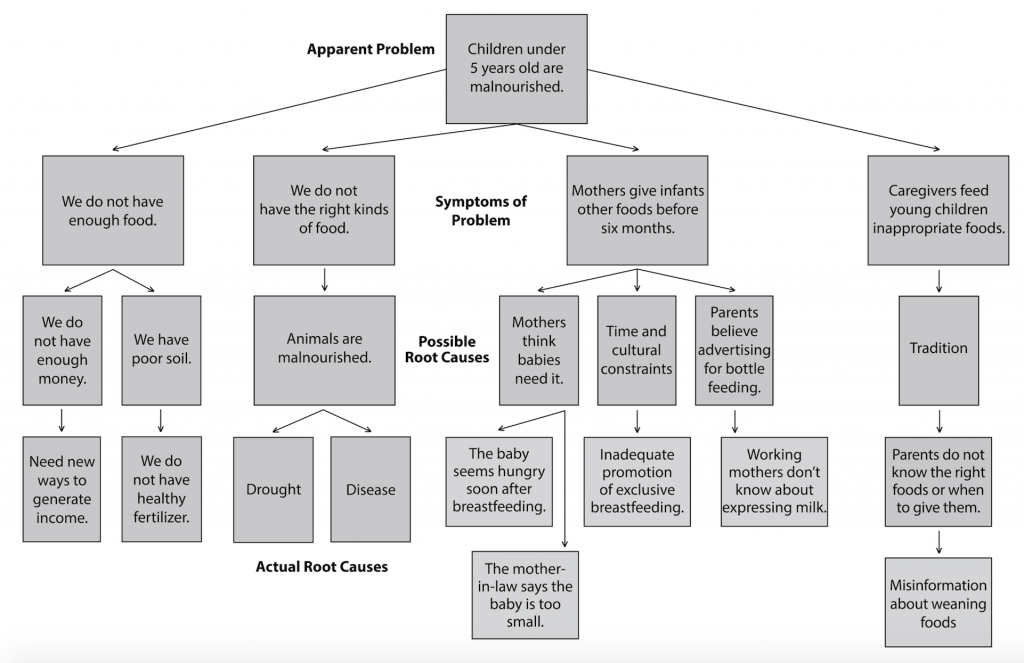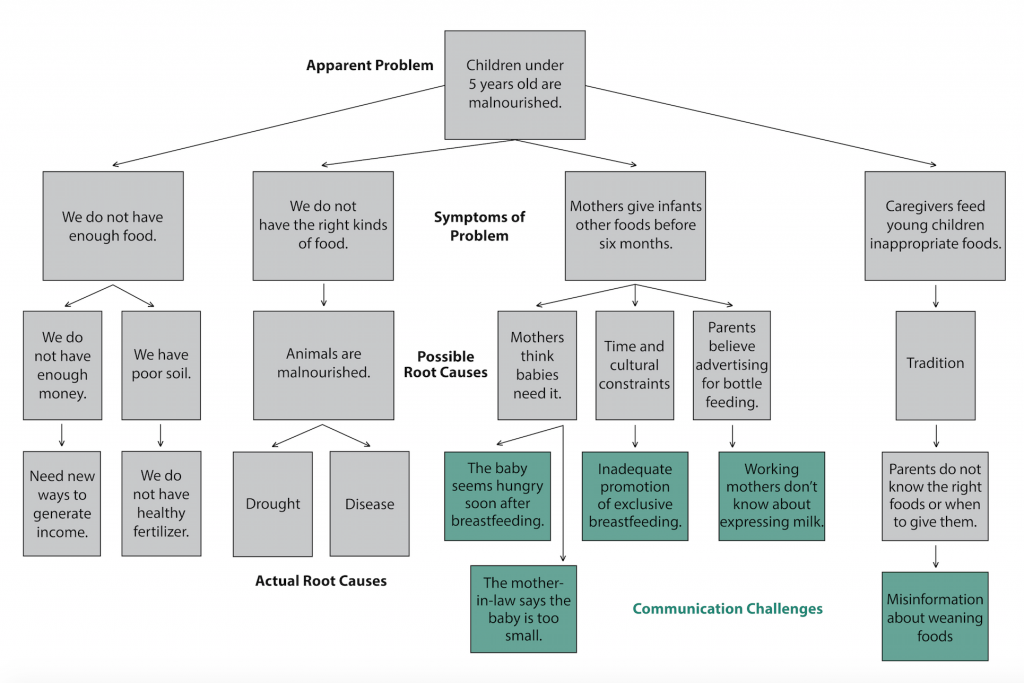Introduction
A root cause analysis is a process used to identify the primary source of a problem. In social and behavior change communication (SBCC), a root cause analysis is used to examine why there is a difference between the desired state of a health or social issue (vision) and what is happening now (current situation).
Why conduct root cause analysis?
A root cause analysis helps to identify the challenges a program should address to reach its vision. SBCC strategies that only address the obvious or most visible aspects of a problem are not likely to succeed. For example, a family planning campaign that only raises women’s knowledge of contraceptives will likely not result in increased family planning use if husbands or mothers-in-law are the primary decision makers regarding family planning use. Identifying the sources – the root causes – of a health problem helps programs develop a more effective strategy to overcome it.
Who should conduct a root cause analysis?
A small, focused team should conduct the root cause analysis. Members should include communication staff, health/social service staff and, if available, research staff. Typically, the same team conducting the situation analysis will also conduct the root cause analysis.
When should a root cause analysis be conducted?
A root cause analysis (or other forms of problem analysis listed in the resource section of this guide) should be conducted as part of the situation analysis. It can take place as part of a stakeholder workshop or, if needed, during additional discussions with stakeholders or audiences.
The steps below will help identify many possible causal factors including the root cause of the health issue identified during the situation analysis.
Estimated Time Needed
Completing a root cause analysis can take up to several hours. Consider how much data is available, how well the data identifies causes and whether additional stakeholder or audience input is needed.
Learning Objectives
After completing the activities in the root cause analysis guide, the team will:
- Know the difference between causal factors and the root cause of a problem.
- Identify causal factors of a public health problem.
- Identify root causes of a public health problem (these will be both program and communication challenges).
- Identify and rank communication challenges.
Prerequisites
Steps
Step 1: Identify Possible Causal Factors
During the situation analysis, the project team set the vision, identified the problem and collected data needed to better understand the current situation. The team can use that information to identify causal factors – things that cause or contribute to the health problem.
To identify causal factors, ask:
- What sequence of events leads to the problem?
- What conditions allow the problem to occur? [E.g., traditional values and practices]
- What problems co-exist with the central problem and might contribute to it? [E.g., lack of health facilities]
Identify as many causal factors as possible. Start with the problem and brainstorm causal factors for that problem by asking “Why?” The desk review conducted during the situation analysis and a stakeholders’ workshop are good places to find causal factors. Project staff can also ask themselves (based on their own experience) and stakeholders “why” or “so what” questions to identify causal factors. Using the problem statement, “children under 5 are malnourished” some causal factors could include:
| Problem | Children under 5 are malnourished |
|---|---|
| Causal Factors | We don’t have enough foodWe don’t have enough moneyWe have poor soilWe don’t have the right kinds of foodAnimals are malnourishedMothers give infants other foods before six monthsMothers think the babies need more foodParents believe advertising for bottle-feedingTime and cultural constraintsCaregivers feed young children inappropriate foodsTraditionParents don’t know the right foods or when to give them |
Step 2: Identify the Root Cause
To find root causes— the primary sources of the health problem —start with the causal factors identified above and ask why, such as “Why are couples not using modern contraceptive methods?” Root causes are seldom found in the most obvious causes. It is important to dig deeper and continue to ask “why?” until nearly all responses have been exhausted or roots that seem important to address are reached. There are several useful methods for identifying root causes.
One method for identifying root causes is to construct a root cause tree. Start with the problem and brainstorm causal factors for that problem by asking why. Connect them in a logical cause and effect order until arriving at the root of the problem. For example:

This process requires good judgment and might involve trial and error. For example, if the team decides to address an identified root cause and the problem continues to occur, that is a good indication it is not the root cause. Take another look at the identified root causes and keep digging deeper to go beyond the symptoms of the problem. Staff can also consult stakeholders and audience members to assess whether they have identified appropriate root causes.
| Note: Removing a causal factor might improve the situation, but it will not necessarily keep the problem from occurring. This is one way to distinguish a causal factor from a root cause. |
Fishbone diagrams and 5 Whys are other methods for identifying problem sources and communication challenges (see the resources section below for examples).
Additional reading suggestion:
Understanding Operational Barriers to Family Planning Services in Conflict-affected Countries: Experiences from Sierra Leone. U.S. Agency for International Development, Health Policy Initiative Sonneveldt, Emily; Shaver, Theresa; Bhuyan, Anita. USAID. 2007.
Step 3: Identify Communication Challenges
Now ask which root causes are challenges that health communication can and should address – communication challenges – and which are not. The example below identifies the communication challenges. Share findings about other root causes with local authorities and leaders or organizations that might be able to address them.

In the example above, asking why questions points to root causes of child malnutrition. Health communication cannot address some of the reasons, such as poor soil and drought. Here, the root causes that represent communication challenges can be summarized as:
- The desire to give babies additional food too soon.
- The prioritization of bottle feeding over breastfeeding.
- Misinformation about weaning foods.
Step 4: Prioritize Communication Challenges
If root cause analysis identifies more than one communication challenge, decide which challenge to address first. Rank root causes in order, starting with the main cause (key communication problem). To determine rank, consider:
- The potential impact of addressing the communication challenge. The greater the potential impact, the more important it is to address.
- How difficult it will be to reach the audience associated with the communication challenge.
- The mandate attached to the funding.
- Other resources available to address the communication challenge. There may be other partners working on that communication challenge or additional funding streams available.
- Whether there is a logical order in which to address the communication challenges. It may make more sense to address negative provider attitudes before generating demand for provider services.
- If more than one causal factor is linked to the root cause. When a root cause is the source of multiple causal factors, it indicates that addressing the root cause can have far-reaching effects.
In the root cause analysis example above, the number one priority might be to address the desire to give babies other foods too soon. Reasons for prioritizing this communication challenge include:
|
Include the prioritized list of communication challenges in the situation analysis to help the creative team focus its efforts. This will help determine what direction the project must take and the kinds of messages, materials and activities to develop.
Templates
Tips & Recommendations
- Identify a root cause that is within the team’s sphere of influence. Stop asking why once the team has identified a root cause that is within their collective ability to control or influence.
- If any cause accounts for more than 70 percent of the causal factors, it can often be considered the root cause.
Lessons Learned
- Stakeholders (including those who practice the behavior to be changed) are not always aware of or able to say why the problem exists or why they do what they do as it relates to the problem. A skilled facilitator can get the answers by: Noticing and remarking on associations made during the discussion; Using brief case study scenarios to get reactions, responses and examples from discussion participants; and Asking questions other than “why.”
Glossary & Concepts
- A causal factor is something that contributes to a problem, but is not a root cause.
- A communication challenge is a root cause that communication can address.
- A root cause is something [a source] that, if removed, will eliminate the problem.
Resources and References
Resources
5 Whys: Getting to the Root of a Problem Quickly
Root Cause Analysis Tracing a Problem to its Origins
References
- Leadership in Strategic Health Communication Handbook, Lozare, Storey, and Bailey
- Root Cause Analysis, Tracing a Problem to Its Core, http://www.mindtools.com/pages/article/newTMC_80.htm
Banner Photo: © 2012 Malcolm Spence/On Call Africa, Courtesy of Photoshare
